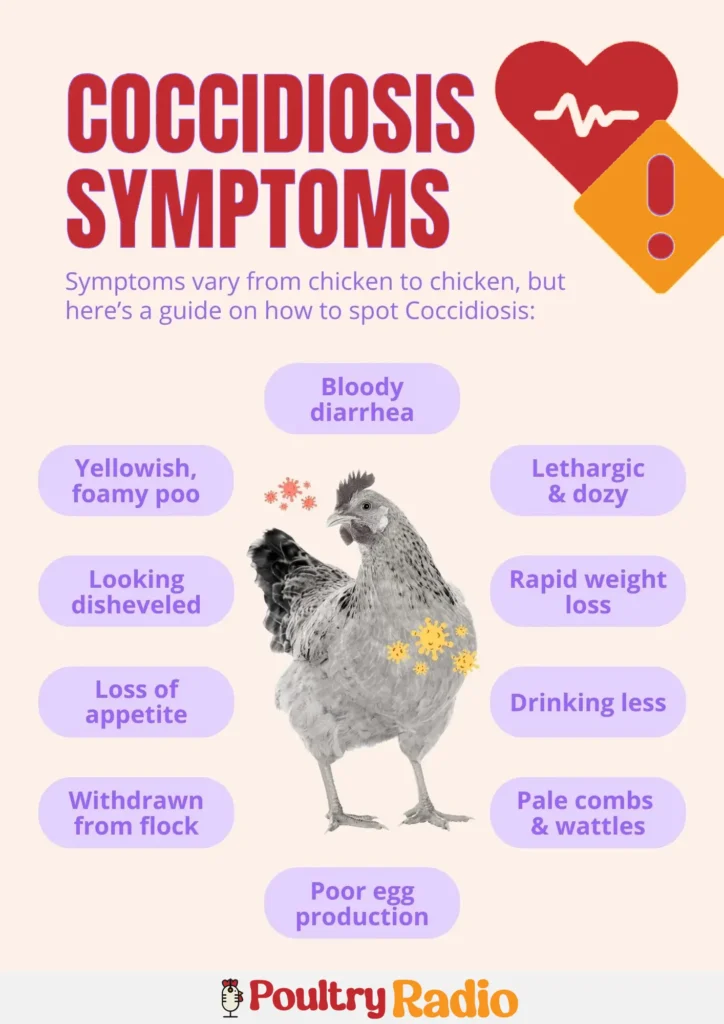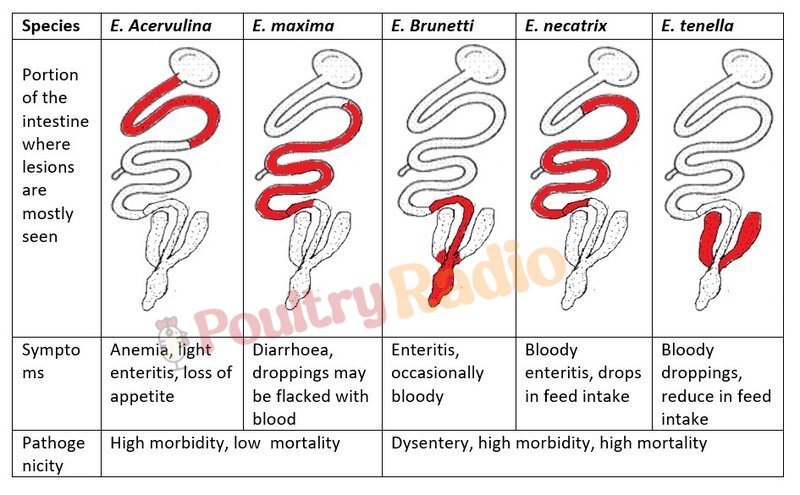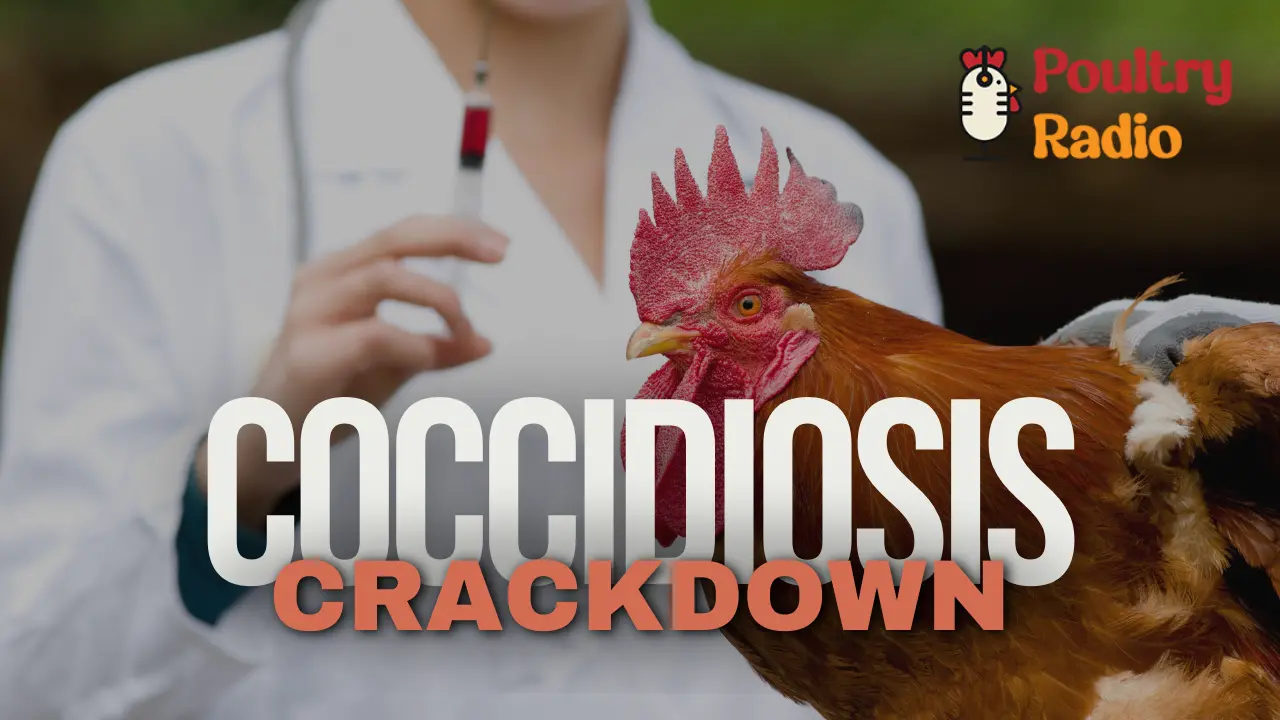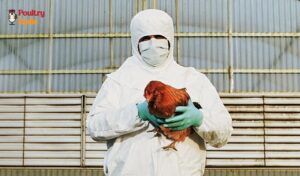Coccidiosis Crackdown: Strategies to Keep Your Poultry Strong and Healthy
Coccidiosis is a parasitic disease that can infect a variety of species, including poultry like chickens and turkeys. It is brought on by a family of microscopic organisms called coccidia, which is also referred to as Eimeria. The host animal’s intestinal lining is invaded by these single-celled parasites, causing varying degrees of intestinal damage and potential health problems.
The disease progresses quickly (within 4–7 days) and is marked by the parasite multiplying in the host’s cells, causing extensive damage to the intestinal lining. Coccidia in poultry usually stick to specific hosts and infect particular parts of the intestine. However, in-game birds like quail and coccidia may infect the entire intestinal tract. Coccidiosis is found in poultry, captive game birds, and wild birds worldwide.
Etiology
Coccidia is commonly found in poultry-raising operations, but birds only develop clinical disease after ingesting large amounts of sporulated oocysts. Susceptible birds, such as those with weakened immune systems or concurrent disease, are at risk. Both sick and recovered birds release oocysts in their feces, contaminating feed, dust, water, litter, and soil.
Transmission can occur through equipment, personnel, insects like flies, and rodents. Fresh oocysts only become infectious after 1-2 days under optimal conditions, with a prepatent period of 4-7 days. Sporulated oocysts can survive for extended periods, while resistance to certain disinfectants is observed.
Pathogenicity of Coccidiosis
The pathogenicity of coccidiosis is influenced by the genetics of the host, nutritional factors, concurrent illnesses, the age of the host, and the specific coccidium species. In chickens, Eimeria necatrix and E tenella are the most harmful, causing significant hemorrhaging.
Typically, protective immunity develops after experiencing moderate and ongoing infections. While true age-related immunity is not observed, older birds are generally more resistant than young birds due to earlier exposure to the infection.
What are the types of Coccidiosis in poultry?
There are mainly two types of cocci.
Caecal coccidiosis:
As the name shows in this type of coccidiosis, the ceca of birds are affected. This type is mainly caused by Eimeria Tenela (The most harmful for chicken in terms of losses in the case of coccidiosis).
Intestinal coccidiosis:
This type of cocci is caused by Eimeria Nacatrix. E. Nacatrix also caused heavy losses in terms of mortality (up to 25%). Intestinal coccidiosis affects relatively older birds.
What are the symptoms of Coccidiosis in Chickens?
- Diarrhea that is either bloody or watery is one of the most obvious symptoms.
- Dehydration from diarrhea can cause tiredness, decreased activity, and sunken eyes.
- Affected birds may have ruffled feathers.
- Reduced feed intake as a result of weight loss.
- In laying birds coccidiosis may cause a drop in egg production.

Postmortem Lesions of Coccidiosis
Lesion characteristics vary depending on the species of Eimeria impacting the intestine. Key diagnostic indicators for identifying the specific Eimeria species affecting a particular flock encompass:
- Location
- Appearance
- The severity of the lesions
The most frequently found Eimeria species in poultry are:
- E. acervulina
- E. brunetti
- E. maxima
- E. necatrix
- E. tenella
Eimeria acervulina is the leading culprit behind infections. Affected areas showcase abundant whitish, oval, or transverse patches in the upper portion of the small intestine, which can be readily identified through a simple visual inspection. Typically, the clinical journey within a flock is prolonged and leads to stunted growth, more culls, and a slight uptick in mortality.
E brunetti is typically located in the lower small intestine, rectum, ceca, and cloaca. In cases of moderate infections, the mucosa appears pale and disrupted, lacking discrete foci, and may be thickened. Severe infections are characterized by coagulative necrosis and sloughing of the mucosa throughout most of the small intestine.
In the small intestine, E maxima leads to the widening and thickening of the wall, as well as tiny areas of bleeding and the release of a reddish-orange/pink viscous fluid. The outer layer of the midgut often shows many small whitish spots and may seem swollen. The oocysts and gametocytes (especially macro gametocytes) found in the affected areas are noticeably large.
Eimeria Necatrix is extremely pathogenic to chickens, often affecting birds between 9 and 14 weeks of age. This parasite causes damage to the middle section of the small intestine, leading to dilation and constriction in some areas, giving it a ballooned appearance. The intestinal lumen often contains blood, mucosal debris, and fluid. The lesions can be observed from the outer surface of the intestine, appearing as white and dark dots with a “salt and pepper” pattern.
Eimeria tenella is dangerous for chickens. It mainly affects the ceca, causing remarkable damage. It often leads to high mortality, significant weight loss, and blood-stained feces. In addition, E. tenella causes hemorrhaging in the ceca and the appearance of white dots (schizonts and oocysts) on the serosal surface. This type of Eimeria penetrates deep into the intestinal tissue, causing severe damage to the mucosa and muscular layer. As a result, the cecal lumen becomes filled with blood clots and necrotic debris.

Prevention and Control of Cocci Disease in Chicken
- To stop coccidia from entering the farm environment, strictly enforce biosecurity measures.
- Restricting access to the property for people, vehicles, and animals. Regularly clean and disinfect poultry housing and equipment, paying close attention to any potential breeding grounds for coccidia.
- Do not overcrowd areas as this can lead to stress and the spread of coccidia.
- Limit your exposure to wet or humid environments because they may facilitate the growth of coccidia.
- A key preventive measure is vaccination. To assist birds and build immunity against particular coccidia species, commercial vaccinations are easily available.
How do you treat Coccidiosis in Chicken?
In the field of poultry production, various antimicrobials or antiprotozoals have been utilized for many years to manage and avoid coccidiosis. The strategies for effectively controlling coccidiosis vary depending on the type of poultry production.
Techniques for treating or preventing coccidiosis:
- Coccidicides
- Coccidiostats
- Live vaccines
- Probiotics
Coccidicides Drugs:
Due to the short life cycle of a broiler, the coccidiosis preventive program typically aims to eliminate Eimeria from the gut using coccidicides that effectively kill the parasites. Toltrazuril and diclazuril are the Coccidioides drugs. This leads to the best possible condition for the gastrointestinal tract, which enhances body weight and decreases feed conversion.
Coccidiostat Drugs:
In breeders and layers, a unique approach is typically required. Because these birds have a relatively long life cycle, it is important to promote the development of protective immunity. To achieve this, a minimal level of exposure to Eimeria is permissible.
To accomplish this goal, coccidiostats are utilized to stop the growth of the parasites at various developmental stages, enabling a well-balanced approach between minimizing intestinal damage and fostering the development of immunity.
These kinds of drugs stop the development and reproduction of coccidia but do not kill them. The most common coccidiostats are Amprolium (Most commonly used) and Salfa-based drugs.
Live vaccines
Live vaccines are frequently used in broiler and layer breeders. The vaccination strategy involves using precocious strains that replicate only a few times in the avian intestine before shedding oocysts or using weakened strains and controlled dosing to minimize damage to the intestinal tract compared to a field strain.
Probiotics
Another great way to combat coccidiosis is by using probiotics, which help introduce healthy bacteria into the digestive system. Studies have revealed that taking probiotics can enhance the body’s defense against various harmful bacteria and parasites.
You can also read about some other common diseases of poultry like New Castle Disease, Infectious Bronchitis, Avian Influenza, and Mycoplasma.
What causes coccidiosis in poultry?
Coccidiosis is a parasitic disease that can infect a variety of species, including poultry like chickens and turkeys. It is brought on by a family of microscopic organisms called coccidia, which is also referred to as Eimeria.
What are the types of coccidiosis in chickens?
There are mainly two types of cocci. Caecal coccidiosis, caused by Ameria Tenalla (The most harmful for chicken in terms of losses in the case of coccidiosis). Intestinal coccidiosis, caused by Eimeria Nacatrix. E. Nacatrix also caused heavy losses in terms of mortality (up to 25%). Intestinal coccidiosis affects relatively older birds.
What is the best natural remedy for coccidiosis?
Another great way to combat coccidiosis is by using probiotics, which help introduce healthy bacteria into the digestive system. Studies have revealed that taking probiotics can enhance the body’s defense against various harmful bacteria and parasites.
What are the 5 symptoms of coccidiosis?
Diarrhea that is either bloody or watery is one of the most obvious symptoms.
Dehydration from diarrhea can cause tiredness, decreased activity, and sunken eyes.
Affected birds may have ruffled feathers.
Reduced feed intake as a result of weight loss.
In laying birds coccidiosis may cause a drop in egg production.








